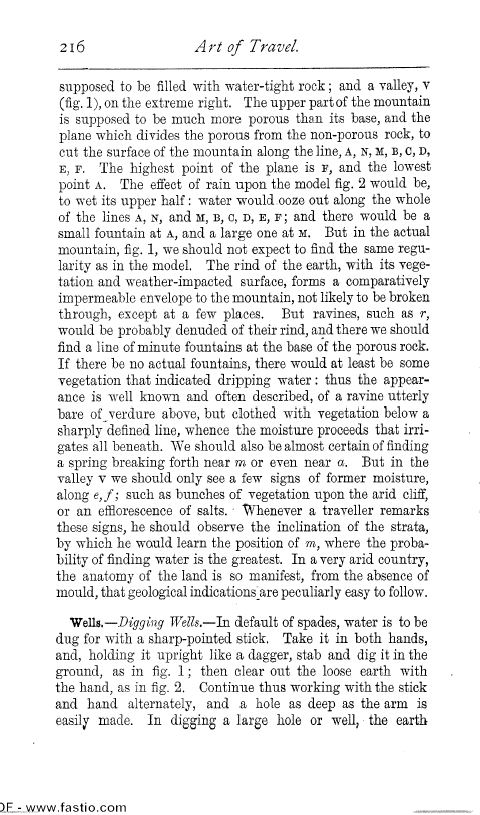| ||||||

OCR Rendition - approximate216 Art of Travel. supposed to be filled with water-tight rock ; and a valley, v (fig. 1), on the extreme right. The upper part of the mountain is supposed to be much more porous than its base, and the plane which divides the porous from the non-porous rock, to cut the surface of the mountain along the line, A, N, M, B, C, D, E, F. The highest point of the plane is F, and the lowest point A. The effect of rain upon the model fig. 2 would be, to wet its upper half : water would. ooze out along the whole of the lines A, N, and M, B, C, D, E, F ; and there would be a small fountain at A, and a large one at m. But in the actual mountain, fig. 1, we should not expect to find the same regularity as in the model. The rind of the earth, with its vegetation and weather-impacted surface, forms a comparatively impermeable envelope to the mountain, not likely to be broken through, except at a few places. But ravines, such as r, would be probably denuded of their rind, and there we should find a line of minute fountains at the base of the porous rock. If there be no actual fountains, there would at least be some vegetation that indicated dripping water : thus the appearance is well known and often described, of a ravine utterly bare of verdure above, but clothed with vegetation below a sharply defined line, whence the moisture proceeds that irrigates all beneath. W e should also be almost certain of finding a spring breaking forth near m or even near a. But in the valley v we should only see a few signs of former moisture, along e, f ; such as bunches of vegetation upon the arid cliff, or an efflorescence of salts. Whenever a traveller remarks these signs, he should observe the inclination of the strata, by which he would learn the position of m, where the probability of finding water is the greatest. In a very arid country, the anatomy of the land is so manifest, from the absence of mould, that geological indications are peculiarly easy to follow. Wells.-Digging Wells.-In default of spades, water is to be dug for with a sharp-pointed stick. Take it in both hands, and, holding it upright like a dagger, stab and dig it in the ground, as in fig. 1; then clear out the loose earth with the hand, as in fig. 2. Continue thus working with the stick and hand alternately, and a hole as deep as the arm is easily made. In digging a large hole or well, the earth )F.,.; www.fastio.com |